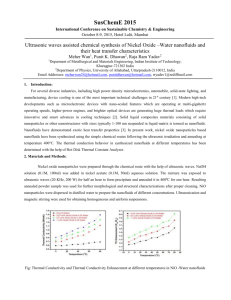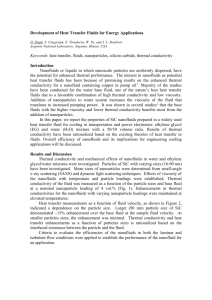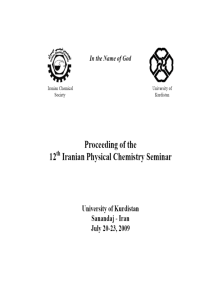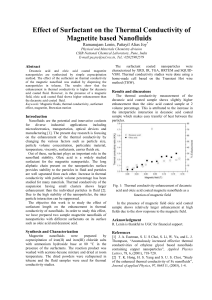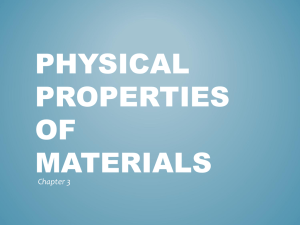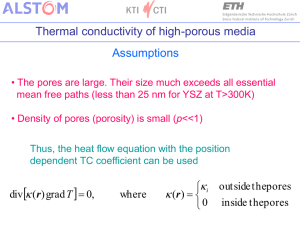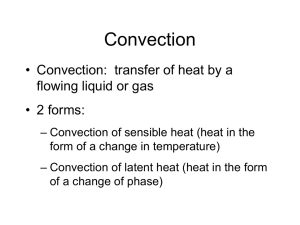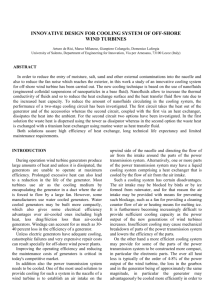Solutions for soil, plant & environmental
advertisement
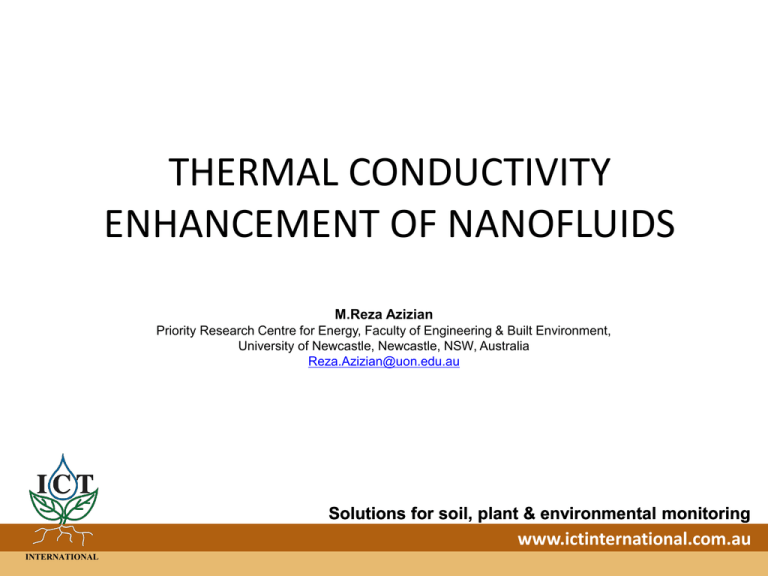
THERMAL CONDUCTIVITY ENHANCEMENT OF NANOFLUIDS M.Reza Azizian Priority Research Centre for Energy, Faculty of Engineering & Built Environment, University of Newcastle, Newcastle, NSW, Australia Reza.Azizian@uon.edu.au Solutions for soil, plant & environmental monitoring 7/04/2015 INTERNATIONAL www.ictinternational.com.au 1 Nanofluids are a new class of engineering colloidal suspensions of nanoparticles (e.g. metal oxides, metals, carbon nanotubes, etc) in a base fluid such as water or organic liquids. Nanofluids show abnormally high thermal conductivities in comparison to conventional heat transfer fluids. The aim of this project is to develop a better understanding of different mechanisms behind these unusual thermophysical properties of the nanofluids. Understanding the different phenomena behind this enhancement is not possible without experiments. Thus, one of the key issues in this project is running different experiments (especially, thermal conductivity measurements) under different conditions. There are four techniques used in literature for measuring the thermal conductivity of different fluids as well as nanofluids. These four are: the Transient Hot Wire (THW) method, Temperature Oscillation (TO), Guarded Hot Plate (GHP), and hot strip method. Solutions for soil, plant & environmental monitoring 7/04/2015 INTERNATIONAL www.ictinternational.com.au 2 KD2-Pro Thermal Properties Analyser, manufactured by Decagon and provided to our laboratory by ICT International Australia, works based on the Transient Hot Wire (THW) theory. KD2-Pro has lots of advantages over the old fashioned THW setup, which led us to select it for our thermal conductivity measurements. Some of these advantages are as follows: It is portable, It can work on an extended temperature ranges (between -50 and 150oC), It has data storage, It has an auto measurement mode that was very useful in allowing to obtain data over a pre-determined time periods, minimising disturbances to the system. KD2 Pro Thermal Properties Analyser Solutions for soil, plant & environmental monitoring 7/04/2015 INTERNATIONAL www.ictinternational.com.au 3 Figure 1 shows the thermal conductivity enhancement by the Al2O3 nanoparticles (<50 nm from Sigma Aldrich) in DI-Water. The thermal conductivity of the nanofluid and based fluid was measured by KD2-Pro. Figure 2 shows that our data has a good consistency with the data reported before in literature. The nanofluid samples have been made by mixing off-the shelf nanoparticles with the base fluid by 5min stir and 3 hours sonication. Ten sets of measurements have been done for each volume concentration and the average taken afterwards. As figure 1 shows, the thermal conductivity of the nanofluids increase with increasing volume concentration. Figure 3 and 4 show the KD2-Pro doing measurements in our laboratory. During our experiments in the laboratory we found out that the KD2-Pro measurements are very sensitive to temperature changes and small vibrations which cause a convection effect. For this reason, all the measurements were carried out in a water-bath and during the night, thereby minimizing any disturbances in the surrounding environment. Solutions for soil, plant & environmental monitoring 7/04/2015 INTERNATIONAL www.ictinternational.com.au 4 Fig.1. Thermal conductivity enhancement of the Al2O3-in-water at different volume concentration Solutions for soil, plant & environmental monitoring 7/04/2015 INTERNATIONAL www.ictinternational.com.au 5 Fig.2. Comparison between present experimental data with data reported in the literature Solutions for soil, plant & environmental monitoring 7/04/2015 INTERNATIONAL www.ictinternational.com.au 6 Fig.3. left: 1% Alumina nanofluid sample, right: KD2-Pro instrument while doing measurements Solutions for soil, plant & environmental monitoring 7/04/2015 INTERNATIONAL www.ictinternational.com.au 7 Fig.4. KD2-Pro measuring the thermal conductivity of the nanofluid sample inside the water bath Fig.5. KD2-Pro housing Solutions for soil, plant & environmental monitoring 7/04/2015 INTERNATIONAL www.ictinternational.com.au 8 References: [1]J. Ma, Thermal conductivity of fluids containing nanometer sized particles, M.S.thesis, Department of Mechanical Engineering, MIT, 2006. [2]D. Yoo, K.S. Hong, H.-S. Yang, Study of thermal conductivity of nanofluids for the application of heat transfer fluids, Thermochimica Acta, vol. 445, no. 1-2, pp.66-69, 2007. [3]R. Gowda, H. Sun, P. Wang, M. Charmchi, F. Gao, Z. Gu, B. Budhlall, Effects of particle surface charge, species, concentration, and dispersion method on the thermal conductivity of nanofluids, Hindawi publishing corporation, Advances in Mechanical Engineering, vol. 2010, article ID 807610. [4]E.V. Timofeeva, A.N. Gavrilov, J.M. McCloskey, Y.V. Tolmachev, S. Sprunt, L.M. Lopatina, J.V. Selinger, Thermal conductivity and particle agglomeration in alumina nanofluids: Experiment and theory, Physical Review E, 76, 061203, 2007. Solutions for soil, plant & environmental monitoring 7/04/2015 INTERNATIONAL www.ictinternational.com.au 9
